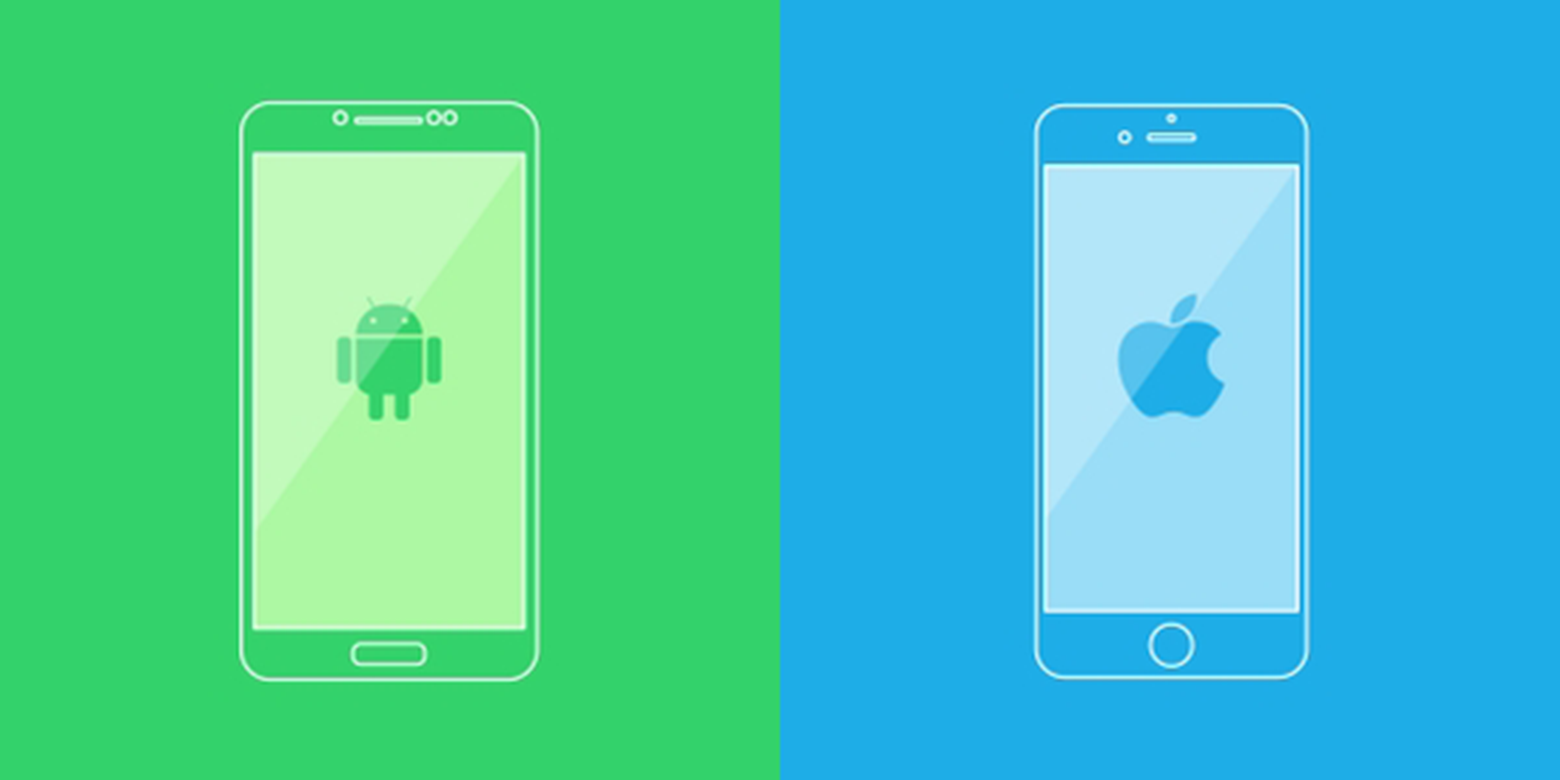Every entrepreneur aspires to create a hit app.
The road to developing a successful app, on the other hand, is long and winding.
When it comes to picking between iOS and Android for their mobile app, business owners and want to be entrepreneurs are frequently perplexed.
However, before you decide which platform to employ for app development, you should understand the differences between iPhone and Android users.
The good news is that there is some excellent research on iPhone vs. Android consumers. There are also a few analytic tools that might assist you in gaining more insights. Analyzing trends and patterns will assist you in developing an amazing app story.
So, in this article, we’ll examine the differences between Android and iPhone users in order to determine which platform is best for your company.
As you can see, the success of your mobile app is heavily reliant on solid research. As a result, it’s critical to understand the fundamental differences in audience behavior.
How Android vs. iPhone Users Behavior Impact Mobile App Development?
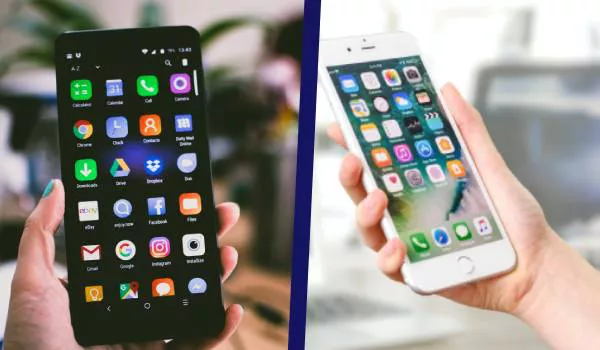
Before we start, let’s take a little detour.
Assume you are vigorously starving, and you are just itching to dig into your favorite food, say, pizza. Do you have a favorite restaurant hangout for pizza? Does it not feel good when your popular hangout remembers your pizza flavorings and other comfort options?
Yes, you read that correctly. It’s nice when a restaurant recalls your preferences, and it’s possible that’s what makes you return.
The food industry’s takeaway: user behavior is crucial!
Let’s take a look at app development for the iPhone or Android.
Before designing a mobile app, you might take a page from the food sector and research iPhone or Android user behavior. Why should you be aware of the distinctions? The simple answer is that you can effectively cater to your customer base!
Winning apps keep the user at the heart of development.
In order to create a mobile app that attracts and retains users, it is critical to consider the user’s behavior and personality traits. It’s a lot like finding your favorite comfort pizza!
It’s giving users ratatouille moments (aha-moments)! Knowing your users’ individual interests and behaviors may help you select pricing, features, and create a strong brand.
A professional approach to analyzing user behavior analytics can assist you in making the best app development platform choice. User behavior analytics may help you create your dream mobile app by providing information like user preferences, purchasing habits, and app engagement and retention.
Android vs. iPhone Users – The Market Share
Here’s a quick look at some interesting statistics on the Android vs. iPhone users market share.
- According to Statista, Apple iOS continues to hold down the largest share of the smartphone operating systems market in the United States. Apple claimed more than half of the market in May 2021.
- The same research highlighted Apple’s share of smartphone users had risen around 23 percent since early 2012. Furthermore, their sustained growth in the United States is not reflected in all markets, and the market share of iOS smartphone shipments drops to around 10 percent.
Let’s look at the mobile operating system market share in the U.S. from December 2020 to December 2021.
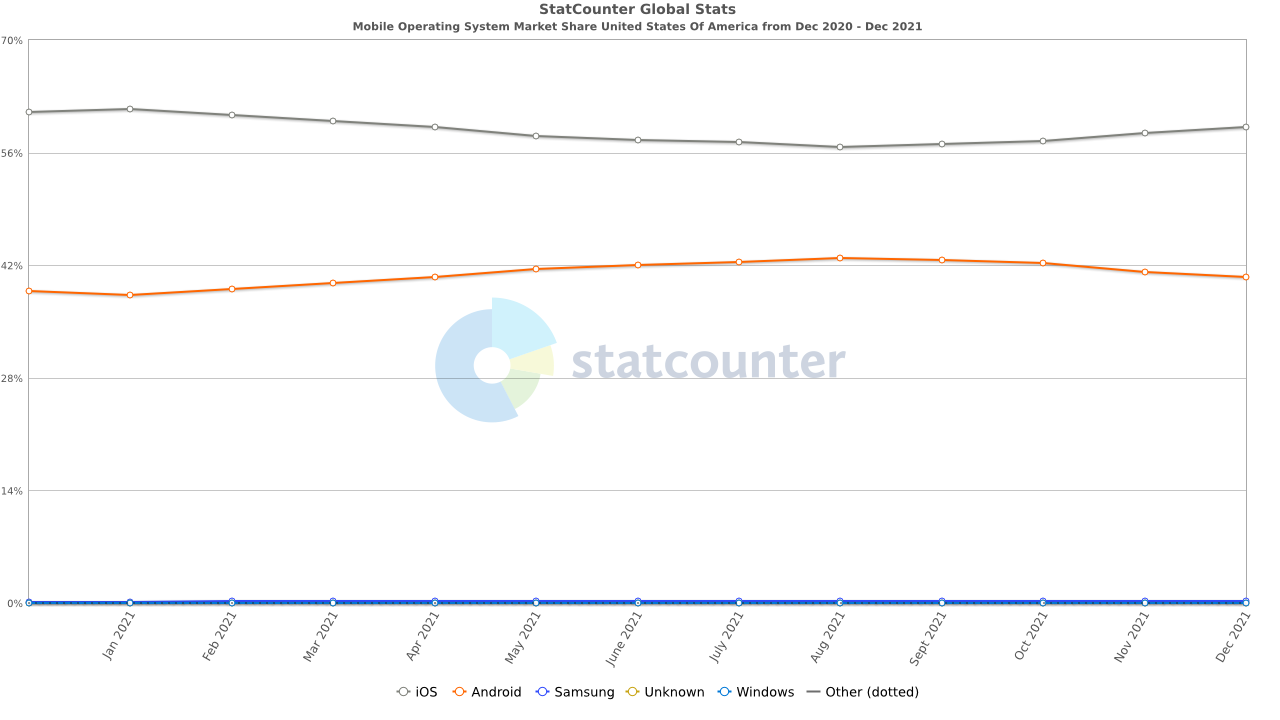
Mobile Operating System Market Share United States Of America (Dec 2020 – Dec 2021) | Image Source
iPhone users certainly have an advantage in the United States. Android has the most global share in developing countries and low-income populations due to its lower entry-level price point. Android has an advantage over Apple in emerging markets such as Asia and Africa.
Knowing your market share is critical as a business. The trend could help you decide whether or not to launch a mobile app.
Difference between iPhone & Android Demographics
User demographics are an important aspect of gaining a better understanding of the users’ characteristics. It could provide you with a bird’s eye view of mobile operating system dynamics.
The finer points, on the other hand, are intriguing because they can help in a variety of ways when designing a mobile application.
1. Income, Education, and Frugality
In terms of popularity, Android is more popular in low-income communities and developing countries. iOS users, on the other hand, are more likely to have a higher income, a higher level of education, be more engaged, and spend more money per app.
Let’s take a look at which countries prefer Android to which countries favor iOS. Android is highlighted in dark blue, while iOS is shown in light blue. The grayed-out countries lack adequate data to assess OS popularity.
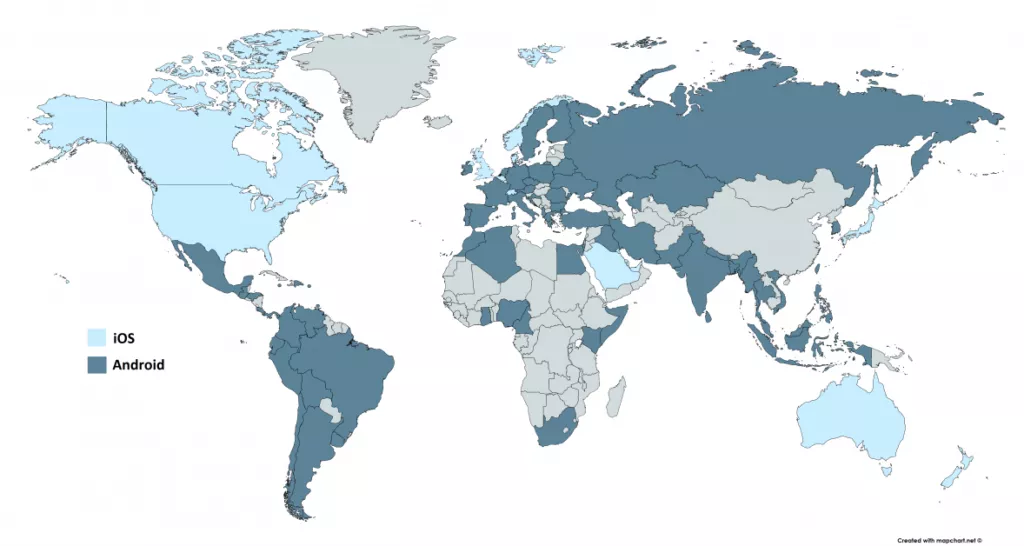
Preferences of Countries for iOS or Android (Q2 2019) | Image Source
Android users are more likely to be middle-class, whereas iPhone users are more likely to be upper-middle-class, according to a survey.
How may such information benefit you as an entrepreneur? Let’s look at one aspect of the answer. The purchasing power and spending habits are shaped by social, economic, and political disparities. Such information can aid in the development of app monetization strategies.
2. Age and gender
Men are slightly more likely than women to use iOS. Android appears to be the most popular platform among all age categories, with an advantage over iOS in the 65+ age group.
Android users are 10% more likely to be men, while iPhone users are 18% more likely to be women, according to the survey.
More Demographic Differences
- Political Views: Android users are more likely to be politically conservative (20%) than their iPhone counterparts, who are more likely to be liberal (17%).
- Introversion vs. Extraversion: Android users are more likely to be introverts (12%), and iPhone users are more likely to be extroverts (14%).
- Frugality: Android users are more likely to save money (29%), and iPhone users are more likely to spend it (26%).
- Early or Late Adopters: Android users are more likely to be late adopters (31%), and iPhone users are more likely to be early adopters (50%).
- Windows or Mac: Android users are more than 100% more likely to be Windows users, and iPhone users are 100% more likely to be Mac users.
(Source)
Analyzing demographics entails understanding more about the user base’s age group and gender. Age and gender have an impact on operating system selection, smartphone usage, in-app purchases, and app download statistics, among other things.
As an entrepreneur, you must consider age, gender, and other user variances between platforms. Though the disparities aren’t enough to sway an app’s platform choice, income and geography should be considered.
Android & iPhone Users: Different Personalities
Between iPhone and Android users, there are a few key psychological distinctions. Knowing the differences is beneficial since you can focus on improving the user experience.
Knowing the differences can help an app developer curate a mobile app that caters to user wants and behavior in a unique way. As a result, customers are happier!
1. Approach to Technology
Every user group has a unique perspective on technology. iOS users are considered early adopters, with a higher likelihood of having accessed the internet prior to 1992.
Android consumers, on the other hand, were late to the game and prefer full-featured apps. Furthermore, iPhone owners are more likely than Android users to own a Mac.
Late adopters of Android, on the other hand, may be less likely to back up their laptops.
2. Brand Loyalty and Satisfaction
When it comes to brand loyalty, iPhone users place a high value on their smartphones.
As a result, customers have always been loyal to Apple as a brand. Android consumers are no less devoted to their phones and Google apps because they can instantly download a large variety of free apps that work smoothly and have longer trial periods.
When it comes to satisfaction, over two-thirds of iPhone owners (62 percent) are quite pleased with their gadgets. On the other hand, Android users have a relatively high percentage of highly satisfied users (48%) although not quite as high as Apple users.
iOS devices have an advantage over Android devices in terms of a greatly upgraded marketing technique that attracts a lot more attention. Many Android users love the openness of their devices, as well as the vast customization options they provide.
Users of iOS devices, on the other hand, cherish the devices’ consistent user interface and familiar interface.
3. Push Notifications Behavior
Push notifications are supported by Android and can be sent by app developers (by default). As a result, a user can disable it in the settings. iPhone users, on the other hand, can choose to receive push alerts as soon as they install an app.
As a result, iPhones have lower opt-in rates for push notifications than their Android counterparts. If a user opts out, you will never hear from them again. The good news is that you can try to re-permission them via a re-permission campaign.
Despite the fact that iPhone users spend more time on their phones than Android users, Android has a higher push notification click-through rate (CTR) of 10.7% compared to iOS’s 4.9 percent.
Furthermore, an iPhone user spends about 7 minutes on average to open a notification, whereas an Android user takes an incredible 48 minutes.
4. Acquisition, in-app Engagement, and Retention
In a given month, iPhone users spend nine hours more on average with their smartphone apps than their Android counterparts.
Despite the fact that Android has a larger worldwide user base, iOS outperforms Android in terms of user engagement.
The cost of acquiring a user varies, according to Statista, based on the anticipated user behavior and the operating system (OS) in issue. The average cost per install for both iOS and Android is $1.75.
So, if you wanted to get a customer who is eager to make in-app purchases, you’d have to spend roughly US$86.72 for iOS and US$77.45 for Android.
However, if you’re looking for a user to subscribe to your app, Android users have a greater cost of acquisition than iOS customers.
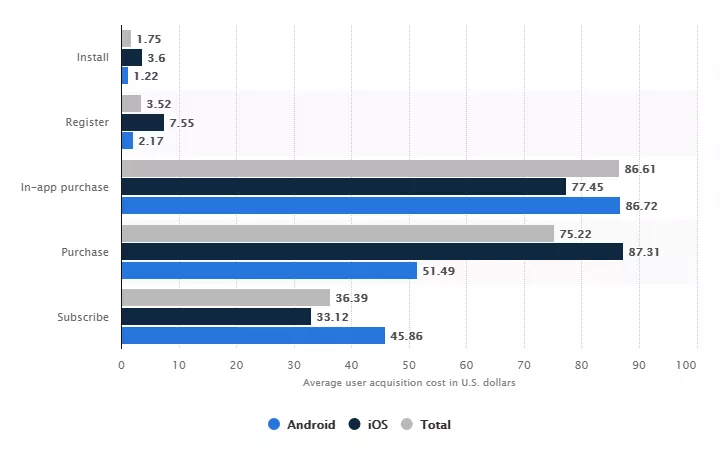
Average Mobile App User Acquisition Costs Worldwide w.r.t User Action and OS | Image Source
iPhone users are frequently described as “power users” of smartphones, who are more likely to engage with more content on average. On the other hand, in each category, the Android platform has a larger number of media users.
As a result, you should consider whether audience size or engagement is the more important factor in your app’s success.
You can consider if a larger number of users or more engaged users is more important to you. Much will be determined by the goal you select for your ideal mobile app.
5. Security and Privacy Awareness
Android users appear to be more aware of the risks involved with app usage than iPhone users when it comes to security and privacy when using apps.
As a result, iPhone users rarely think about apps sending premium-rate SMS. Furthermore, when it comes to deciding whether or not to use a new app, Android users are more likely to cite security, privacy, and trust concerns.
6. Gaming Experience
When it comes to buying a smartphone, the gaming experience can be very important. It’s crucial to work on a fantastic gaming experience as an app developer. The iOS App Store has a smaller selection of games, but they are substantially more enjoyable.
Most major gaming studios, on the other hand, create games for both sorts of devices. There are, however, a few fascinating games that are exclusive to one of the app stores.
When it comes to examining games, Android users are harsher than iOS users, according to studies. The data reveals why iPhone users are satisfied with their gaming experience.
Android smartphone owners have an advantage in terms of the quantity of hours spent playing complicated games since they can take advantage of the large RAM available on their devices. Users can also improve their current ROM on their own. When it comes to games that require a lot of memory, Android devices outperform Apple devices because of their open-source functionality.
The two major behemoths, Android and iPhone, each have their unique strengths and advantages. It’s interesting to consider user behavior analytics as an app developer because it can help you better understand your user base.
The final question is: which platform should you use to create a mobile app?
You might reach out to a professional technological solution provider like WDX Technologies, who can guide you through the mobile app curating process.
iPhone or Android: When to Choose Which One
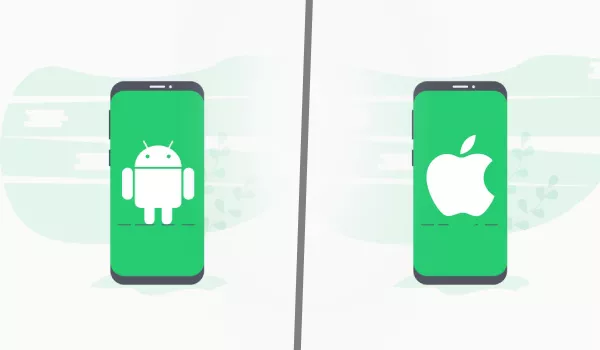
Your final decision will usually be based on your app development objectives. Before designing an app, entrepreneurs can consider what is most important.
Android has the upper hand in terms of market share, which means that entrepreneurs may reach a larger audience.
For advertisers, the iPhone creates a more appealing audience by highlighting more highly engaged mobile media users with better income. The iPhone’s strong platform loyalty is a key factor in the company’s ability to maintain and grow market share over time.
It’s crucial to comprehend the numeric and qualitative distinctions in each device’s user behavior. The information is crucial for making better decisions about target audiences and platforms.
So, what are your objectives? Is it about attracting people, increasing engagement, increasing ROI, or increasing sales?
You can optimize analytics to reach your strategic business objectives after you understand the granular subtleties of user behavior.
The key is to keep your users at the heart of development, enjoy learning more about your user base, and creating a blockbuster app!
Build Blockbuster Mobile Apps Curated for Android or iPhone users with WDX Technologies
Creating a successful software solution is a difficult task. The app development journey might be really beneficial if you choose the correct technology solution provider.
We can lead you through the entire app curation process, guiding you through the finer points of user behavior and optimizing for them. We are a multi-award-winning mobile app development business with a track record of delivering outstanding digital solutions to clients across a variety of sectors.
Got A New Project?
Book a meeting with one of our team members or get a ball park estimation on your project.
Book A MeetingGet A Rough EstimateRelated Articles
Translating innovation to sustainable business growth.
Let’s Work Together to Create the Future We Want
WDX Technologies helps businesses turn their ideas into successful digital realities. We excel in creating digital solutions that solve critical pain points while making you and your customers the HERO.


